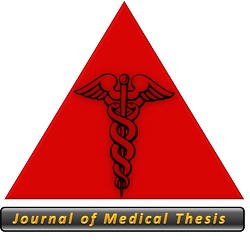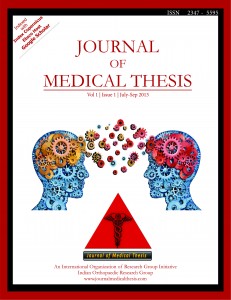Plagiarism in Thesis Writing: Role, Types, Detection, Ethical Implications, and Prevention
Vol 11 | Issue 1 | January-June 2025 | page: 3-5 | Sachin Kale, Sushant Srivastava, Arvind Vatkar, Ashok Shyam, Mohin Darvesh, Abhishek Bhati
https://doi.org/10.13107/jmt.2025.v11.i01.232
Author: Sachin Kale [1], Sushant Srivastava [1], Arvind Vatkar [2], Ashok Shyam [3], Mohin Darvesh [1], Abhishek Bhati [1]
[1] Department of Orthopaedics, D Y Patil Hospital, Navi Mumbai, Maharashtra, India.
[2] Department of Orthopaedics, MGM Medical College, Navi Mumbai, Maharashtra, India.
[3] Department of Orthopaedics, Sancheti Institute for Orthopaedics and Rehabilitation, Pune, Maharashtra, India.
Address of Correspondence
Dr. Sachin Kale,
Department of Orthopaedics, D Y Patil Hospital, Navi Mumbai, Maharashtra, India.
E-mail:sachinkale@gmail.com
Abstract
Plagiarism remains a critical ethical challenge in academia, particularly in postgraduate thesis writing, where originality and independent thought are cornerstones of scholarly development. Despite widespread awareness, instances of plagiarism—both intentional and unintentional—are on the rise, driven by academic pressure, lack of training in research ethics, and easy access to online content. This article provides a comprehensive overview of plagiarism, emphasizing its significance in postgraduate education. It explores the types and methods of plagiarism, mechanisms for its detection, ethical ramifications, and steps to prevent it. The aim is to foster a culture of academic integrity and responsible research practices among students and educators alike.
1. Introduction
A postgraduate thesis represents a student’s transition from a consumer of knowledge to a contributor to scientific literature. However, this journey is fraught with challenges, one of the most pressing being plagiarism. The digital age has enabled easy access to information, and with it, the ease of copying content without proper acknowledgment. In thesis writing, where originality is paramount, plagiarism compromises the academic integrity of the work, the reputation of the student and guide, and the credibility of the institution.
Plagiarism is not just an academic misdemeanor—it is a moral and legal transgression that undermines the research process and the pursuit of truth.
________________________________________
2. The Role and Importance of Plagiarism Awareness in Postgraduate Thesis
Plagiarism awareness serves multiple critical roles in postgraduate education:
• Academic Integrity: A plagiarism-free thesis reflects the true capability and effort of a postgraduate student.
• Professional Ethics: Ethical research habits begin during thesis work and extend into clinical, scientific, or corporate careers.
• Knowledge Contribution: A plagiarized thesis adds nothing new to the scientific body of knowledge.
• Institutional Reputation: Repeated plagiarism cases can damage the credibility of educational institutions.
• Regulatory Compliance: National Medical Commission (NMC), UGC, and other bodies mandate plagiarism checks for theses and publications.
________________________________________
3. Types of Plagiarism (With Examples)
A. Direct (Verbatim) Plagiarism
Copying another author’s work word-for-word without citation.
• Example: Copying an introduction paragraph from a published article into the thesis without quotes or a reference.
B. Self-Plagiarism
Reusing one’s own previously submitted work without acknowledgment.
• Example: Using data from an earlier undergraduate project or a published paper as part of the thesis without citation.
C. Mosaic Plagiarism (Patchwork Writing)
Pasting parts from multiple sources with or without minor alterations.
• Example: Lifting multiple sentences from different websites and rearranging them into a new paragraph.
D. Paraphrasing Plagiarism
Rewriting another author’s content in one’s own words without credit.
• Example: Restating a textbook concept in different words but not citing the original source.
E. Source-Based Plagiarism
Using incorrect or fabricated citations.
• Example: Citing articles that do not exist or referencing irrelevant material to mask plagiarism.
F. Accidental (Unintentional) Plagiarism
Occurs due to negligence or lack of understanding of citation norms.
• Example: Forgetting to cite a source in a paragraph or citing a source incorrectly.
________________________________________
4. Common Methods Used for Plagiarism
Plagiarism can be committed through several deliberate or careless methods:
Method Description
Copy-Paste- Direct extraction of text from books, articles, or websites.
Translation Plagiarism- Translating content from another language and presenting it as original.
AI/Paraphrasing Tools- Using online rephrasing tools to avoid detection by software.
Collusion- Taking help from peers or professionals to write portions of the thesis.
Ghostwriting- Outsourcing the entire thesis to a third party.
Mix-and-Match- Combining text from multiple sources to form a “new” paragraph.
________________________________________
5. Detection of Plagiarism
Academic institutions increasingly rely on software to ensure the originality of submitted theses.
A. Plagiarism Detection Software
Tool Key Features
Turnitin- Widely used; checks against student papers, journals, and internet content.
iThenticate- Preferred by publishers and journals; used for scholarly articles.
Grammarly Premium- Offers a basic plagiarism checker with grammar support.
URKUND- AI-based tool used by many Indian universities.
PlagScan- Customizable for institutional needs.
Similarity Index is usually expressed as a percentage. Most institutions set a threshold (often <10–15% excluding references) for acceptance.
B. Manual Review by Experts
• Recognizing style inconsistency or content mismatch.
• Cross-verifying doubtful data or references.
________________________________________
6. Pros and Cons of Plagiarism (For Understanding Only)
Though unethical, understanding why students plagiarize helps in designing preventive strategies.
Perceived “Pros” (Illusory and Risky)
• Saves time under pressure.
• Easy access to well-written content.
• Ensures technical accuracy if content is borrowed from reputed sources.
⚠️ These are false advantages that come at the cost of severe academic, legal, and ethical repercussions.
Real Cons
• Academic penalties: Thesis rejection, re-submission, disciplinary action.
• Reputation loss: Among peers, faculty, and future employers.
• Disqualification: From future publications, fellowships, and research grants.
• Legal action: In cases of copyright infringement.
• Loss of trust: Between student and guide, or within academic institutions.
________________________________________
7. Ethical and Legal Implications
• Academic Ethics: Breaching the trust of the academic community.
• Legal Implications: Violating copyright laws and intellectual property rights.
• Professional Misconduct: Leading to job losses or license revocation in medical and academic fields.
• Institutional Damage: Accreditation bodies may penalize institutions with high plagiarism rates.
________________________________________
8. Strategies to Prevent Plagiarism
A. Education and Training
• Introduce modules on research ethics and citation techniques.
• Conduct workshops on scientific writing and originality.
B. Use of Plagiarism Checkers
• Mandate plagiarism screening before submission.
• Interpret similarity reports effectively (excluding bibliography, common phrases).
C. Promote Ethical Culture
• Faculty must model ethical behavior.
• Encourage original thinking and critical analysis over rote completion.
D. Improve Student Support
• Address causes like language barriers, writing anxiety, or lack of confidence.
• Provide thesis-writing mentorship programs.
________________________________________
9. Conclusion
Plagiarism is a serious offense that threatens the core of academic excellence. In postgraduate thesis writing, where the goal is to contribute original ideas and research findings, plagiarism—whether intentional or accidental—can have lifelong repercussions. It erodes trust, damages reputations, and jeopardizes careers. Institutions must invest in preventive education, enforce strict plagiarism policies, and promote a culture of integrity. A thesis should be a proud reflection of a student’s academic journey—not a shadow of someone else’s work.
________________________________________
10. Key Learning Points
✅ Plagiarism is not just copying—it includes paraphrasing, self-plagiarism, and improper citation.
✅ There are various types: direct, mosaic, self, paraphrasing, accidental, and source-based.
✅ Software tools like Turnitin and iThenticate help detect plagiarism efficiently.
✅ Preventive strategies include ethics education, proper referencing, and awareness.
✅ Plagiarism has serious academic, legal, and professional consequences.
✅ A thesis is a student’s academic fingerprint—it must be original, ethical, and reflective of independent thought.
| How to Cite this Article: Kale S, Srivastava S, Vatkar A, Shyam A, Darvesh M, Bhati A|Plagiarism in Thesis Writing: Role, Types, Detection, Ethical Implications, and Prevention | Journal of Medical Thesis | 2025 January-June; 11(1): 3-5. |
Full Text HTML | Full Text PDF




